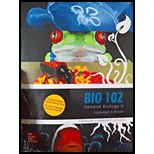
BIO 102 General Biology II Updated Edition (Tidewater Community College)
3rd Edition
ISBN: 9781259614064
Author: Tidewater Community College
Publisher: MCG CUSTOM
expand_more
expand_more
format_list_bulleted
Concept explainers
Question
Chapter 32.1, Problem 2MC
Summary Introduction
To explain:
The three factors that affect an animal’s metabolic rate.
Concept introduction:
The quantity of energy utilized by the body of an animal over a given time is known as the metabolic rate of the animal. The measurement of metabolic rate is done as oxygen consumption per unit time or carbon dioxide produced per unit time or energy produced per unit time.
Expert Solution & Answer
Want to see the full answer?
Check out a sample textbook solution
Students have asked these similar questions
Which evidence-based stress management techniques are most effective in reducing chronic stress and supporting college students’ academic success?
students in a science class investiged the conditions under which corn seeds would germinate most successfully. BAsed on the results which of these factors appears most important for successful corn seed germination.
I want to write the given physician orders in the kardex form
Chapter 32 Solutions
BIO 102 General Biology II Updated Edition (Tidewater Community College)
Ch. 32.1 - What are two reasons that animals must eat?Ch. 32.1 - Prob. 2MCCh. 32.1 - Prob. 3MCCh. 32.1 - How does the mechanical breakdown of food speed...Ch. 32.1 - Define the terms herbivore, carnivore,...Ch. 32.2 - Prob. 1MCCh. 32.2 - Prob. 2MCCh. 32.2 - Prob. 3MCCh. 32.3 - Prob. 1MCCh. 32.3 - Describe the functions of saliva, teeth, and the...
Ch. 32.3 - Prob. 3MCCh. 32.3 - Prob. 4MCCh. 32.3 - Prob. 5MCCh. 32.3 - Prob. 6MCCh. 32.3 - Prob. 7MCCh. 32.4 - Prob. 1MCCh. 32.4 - Prob. 2MCCh. 32.4 - Describe the relationship of body weight to...Ch. 32.4 - Prob. 4MCCh. 32.5 - Prob. 1MCCh. 32.5 - Prob. 2MCCh. 32 - Prob. 1MCQCh. 32 - Prob. 2MCQCh. 32 - Prob. 3MCQCh. 32 - Prob. 4MCQCh. 32 - Prob. 5MCQCh. 32 - Prob. 6MCQCh. 32 - Prob. 1WIOCh. 32 - Prob. 2WIOCh. 32 - Biologists estimate that carnivores assimilate 90%...Ch. 32 - Prob. 4WIOCh. 32 - Prob. 5WIOCh. 32 - Prob. 6WIOCh. 32 - Prob. 7WIOCh. 32 - Prob. 8WIOCh. 32 - Prob. 9WIOCh. 32 - Prob. 10WIOCh. 32 - Prob. 11WIOCh. 32 - Prob. 12WIOCh. 32 - Prob. 13WIOCh. 32 - Prob. 14WIOCh. 32 - Prob. 1PITCh. 32 - Prob. 2PITCh. 32 - Prob. 3PIT
Knowledge Booster
Learn more about
Need a deep-dive on the concept behind this application? Look no further. Learn more about this topic, biology and related others by exploring similar questions and additional content below.Similar questions
- Amino Acid Coclow TABle 3' Gly Phe Leu (G) (F) (L) 3- Val (V) Arg (R) Ser (S) Ala (A) Lys (K) CAG G Glu Asp (E) (D) Ser (S) CCCAGUCAGUCAGUCAG 0204 C U A G C Asn (N) G 4 A AGU C GU (5) AC C UGA A G5 C CUGACUGACUGACUGAC Thr (T) Met (M) lle £€ (1) U 4 G Tyr Σε (Y) U Cys (C) C A G Trp (W) 3' U C A Leu בוט His Pro (P) ££ (H) Gin (Q) Arg 흐름 (R) (L) Start Stop 8. Transcription and Translation Practice: (Video 10-1 and 10-2) A. Below is the sense strand of a DNA gene. Using the sense strand, create the antisense DNA strand and label the 5' and 3' ends. B. Use the antisense strand that you create in part A as a template to create the mRNA transcript of the gene and label the 5' and 3' ends. C. Translate the mRNA you produced in part B into the polypeptide sequence making sure to follow all the rules of translation. 5'-AGCATGACTAATAGTTGTTGAGCTGTC-3' (sense strand) 4arrow_forwardWhat is the structure and function of Eukaryotic cells, including their organelles? How are Eukaryotic cells different than Prokaryotic cells, in terms of evolution which form of the cell might have came first? How do Eukaryotic cells become malignant (cancerous)?arrow_forwardWhat are the roles of DNA and proteins inside of the cell? What are the building blocks or molecular components of the DNA and proteins? How are proteins produced within the cell? What connection is there between DNA, proteins, and the cell cycle? What is the relationship between DNA, proteins, and Cancer?arrow_forward
- please fill in the empty sports, thank you!arrow_forwardIn one paragraph show how atoms and they're structure are related to the structure of dna and proteins. Talk about what atoms are. what they're made of, why chemical bonding is important to DNA?arrow_forwardWhat are the structure and properties of atoms and chemical bonds (especially how they relate to DNA and proteins).arrow_forward
- The Sentinel Cell: Nature’s Answer to Cancer?arrow_forwardMolecular Biology Question You are working to characterize a novel protein in mice. Analysis shows that high levels of the primary transcript that codes for this protein are found in tissue from the brain, muscle, liver, and pancreas. However, an antibody that recognizes the C-terminal portion of the protein indicates that the protein is present in brain, muscle, and liver, but not in the pancreas. What is the most likely explanation for this result?arrow_forwardMolecular Biology Explain/discuss how “slow stop” and “quick/fast stop” mutants wereused to identify different protein involved in DNA replication in E. coli.arrow_forward
arrow_back_ios
SEE MORE QUESTIONS
arrow_forward_ios
Recommended textbooks for you
 Human Physiology: From Cells to Systems (MindTap ...BiologyISBN:9781285866932Author:Lauralee SherwoodPublisher:Cengage Learning
Human Physiology: From Cells to Systems (MindTap ...BiologyISBN:9781285866932Author:Lauralee SherwoodPublisher:Cengage Learning Human Biology (MindTap Course List)BiologyISBN:9781305112100Author:Cecie Starr, Beverly McMillanPublisher:Cengage Learning
Human Biology (MindTap Course List)BiologyISBN:9781305112100Author:Cecie Starr, Beverly McMillanPublisher:Cengage Learning Biology: The Dynamic Science (MindTap Course List)BiologyISBN:9781305389892Author:Peter J. Russell, Paul E. Hertz, Beverly McMillanPublisher:Cengage Learning
Biology: The Dynamic Science (MindTap Course List)BiologyISBN:9781305389892Author:Peter J. Russell, Paul E. Hertz, Beverly McMillanPublisher:Cengage Learning


Human Physiology: From Cells to Systems (MindTap ...
Biology
ISBN:9781285866932
Author:Lauralee Sherwood
Publisher:Cengage Learning

Human Biology (MindTap Course List)
Biology
ISBN:9781305112100
Author:Cecie Starr, Beverly McMillan
Publisher:Cengage Learning



Biology: The Dynamic Science (MindTap Course List)
Biology
ISBN:9781305389892
Author:Peter J. Russell, Paul E. Hertz, Beverly McMillan
Publisher:Cengage Learning